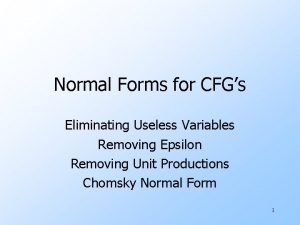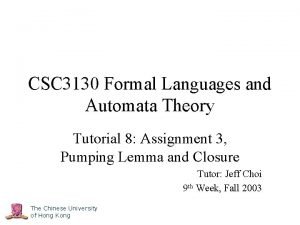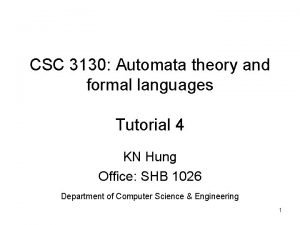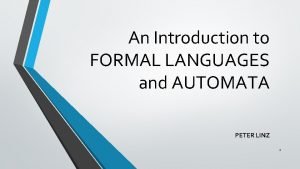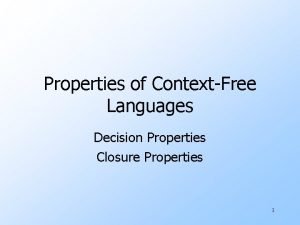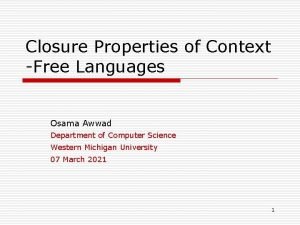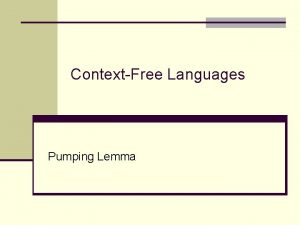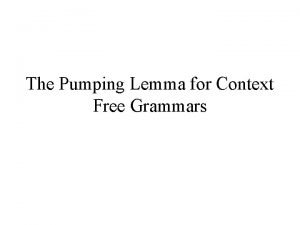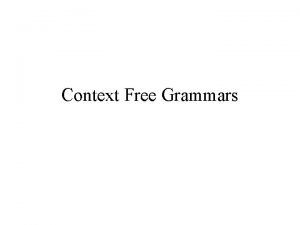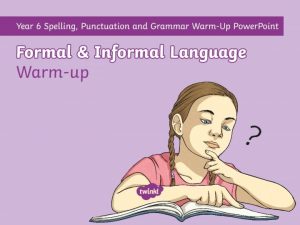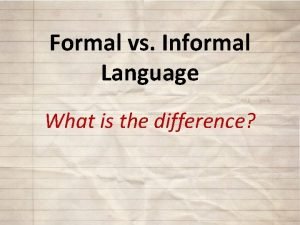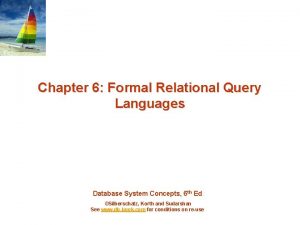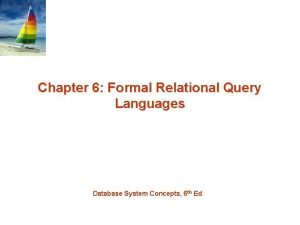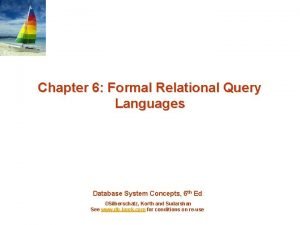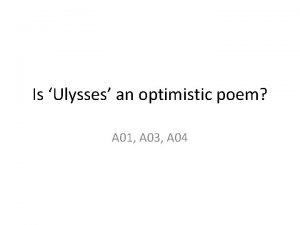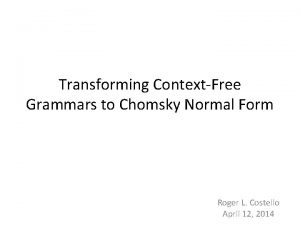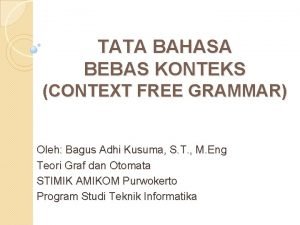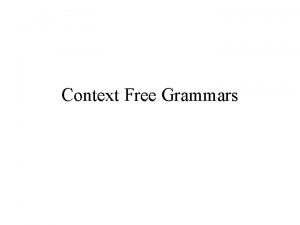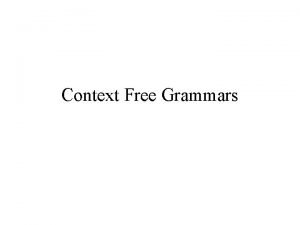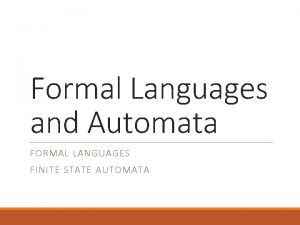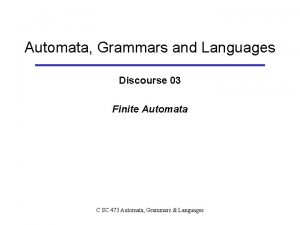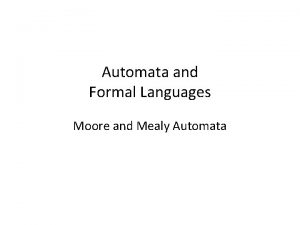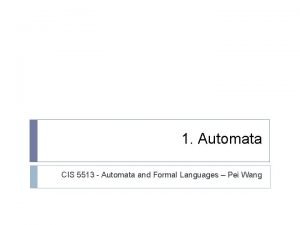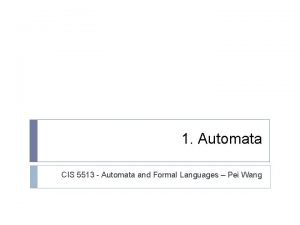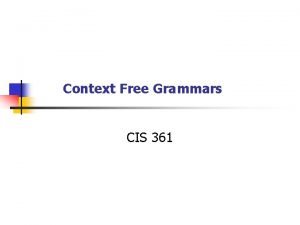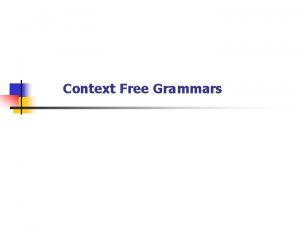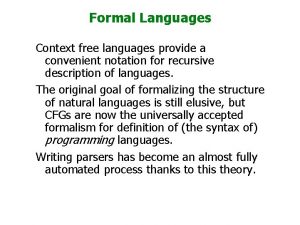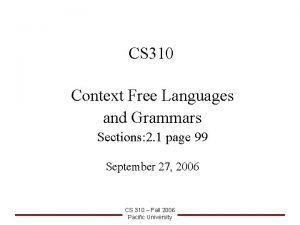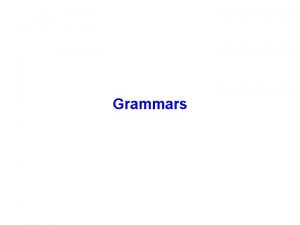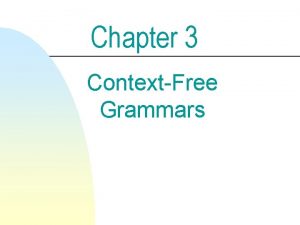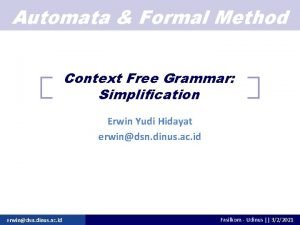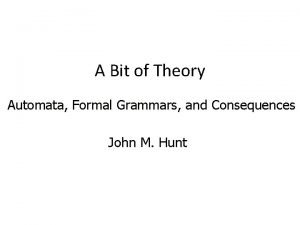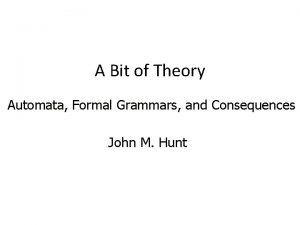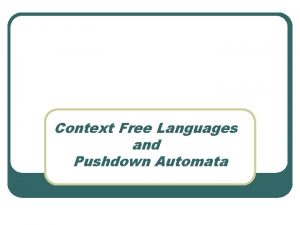Automata and Formal Languages Context Free Grammars Sipser
































- Slides: 32

Automata and Formal Languages Context Free Grammars Sipser pages 100 - 109 Lecture 11 Tim Sheard 1

Formal Languages 1. Context free languages provide a convenient notation for recursive description of languages. 2. The original goal of formalizing the structure of natural languages is still elusive, but CFGs are now the universally accepted formalism for definition of (the syntax of) programming languages. 3. Writing parsers has become an almost fully automated process thanks to this theory.

A Simple Grammar for English Example taken from Floyd & Beigel. <Sentence> ® <Subject> <Predicate> <Subject> ® <Pronoun 1> | <Pronoun 2> <Pronoun 1> ® I | we | you | he | she | it | they <Noun Phrase> ® <Simple Noun Phrase> | <Article> <Noun Phrase> <Article> ® a | an | the <Simple Noun Phrase> ® <Noun> | <Adjective> <Simple Noun Phrase> <Predicate> ® <Verb> | <Verb> <Object> ® <Pronoun 2> | <Noun Phrase> <Pronoun 2> ® me | us | you | him | her | it | them <Noun> ® . . . <Verb> ® . . . 1. 2. 3. 4. Each rule is called a production lhs ® lhs is a symbol, rhs is a string of symbols Variable (or non-terminal) < … > Symbol (or terminal) bold

Example Derive the sentence “She drives a shiny black car” from these rules. sentenc e subject predicat e pronou n 1 objec t verb Noun phrase article Simple Noun phrase adjectiv e Simple noun phrase Nou n She drives a shiny black car

Derivation rules 1. Write down the start symbol rule, unless otherwise stated) (lhs of the first 2. Find a variable, v, and a corresponding rule where: v ® rhs 3. Replace the variable with the string rhs 4. Repeat, starting at 2. until no more variables remain.

Derivation <sentence> Þ I Have underlined the <subject> <predicate> Þ variable I will replace in the next step. <pronoun> <predicate> Þ She <verb> <object> Þ She drives <simple noun phrase> Þ She drives <article> <noun phrase> Þ She drives a <adjective> <noun phrase> Þ She drives a shiny <adjective> <simple noun phrase> Þ She drives a shiny black <noun> Þ She drives a shiny black car

A Grammar for Expressions <Expression> ® <Term> | <Expression> + <Term> ® <Factor> | <Term> * <Factor> ® <Identifer> | ( <Expression> ) <Identifier> ® x|y|z|… In class exercise: Derive • x + ( y * 3) • x+z*w+q

Definition of Context-Free-Grammars A CFG is a quadruple G= (V, S, R, S), where – V is a finite set of variables (nonterminals, syntactic categories) – S is a finite set of terminals – R is a finite set of productions -- rules of the form X¾®a, where XÎV and aÎ(V È S)* – S, the start symbol, is an element of V Vertical bar (|), as used in the examples on the previous slide, is used to denote a set of several productions (with the same lhs).

Example <Expression> ® <Term> | <Expression> + <Term> ® <Factor> | <Term> * <Factor> ® <Identifer> | ( <Expression> ) <Identifier> ® x|y|z|… V = {<Expression>, <Term>, <Factor>, <Identifier>} S = {+, *, (, ), x, y, z, …} R={ <Expression> ® <Term> <Expression> ® <Expression> + <Term> ® <Factor> <Term> ® <Term> * <Factor> ® <Identifer> <Factor> ® ( <Expression> ) <Identifier> ®x <Identifier> ®y <Identifier> ®z <Identifier> ® … } S = <Expression>

Notational Conventions a, b, c, … (lower case, beginning of alphabet) are concrete terminals; u, v, w, x, y, z (lower case, end of alphabet) are for strings of terminals a, b, g, … (Greek letters) are for strings over (T È V) (sentential forms) A, B, C, … (capitals, beginning of alphabet) are for variables (for non-terminals). X, Y, Z are for variables standing for terminals.

Short-hand Note. We often abbreviate a context free grammar, such as: G 2 = ( V={S}, S={(, )}, R={ S ® e, S ® SS, S ® (S) }, S=S} By giving just its productions S ® e | SS |(S) And by using the following conventions. 1) The start symbol is the lhs of the first production. 2) Multiple production for the same lhs non-terminal can be grouped together by using vertical bar ( | ) 3) Non-terminals are capitalized. 4) Terminal-symbols are lower case or non-alphabetic.

Definitions The single-step derivation relation Þ on (VÈ T)* is defined by: 1. a Þ b iff b is obtained from a by replacing an occurrence of the lhs of a production with its rhs. That is, a'Aa'' Þ a'ga'' is true iff A ® g is a production. We say a'Aa'' yields a'ga'' 2. We write a Þ* b when b can be obtained from a through a sequence of several (possibly zero) derivation steps. 3. The language of the CFG , G, is the set L(G) = {wÎT* | S Þ* w} (where S is the start symbol of G) 1. Context-free languages are languages of the form L(G)

Example 1 The familiar non-regular language L = { a kb k | k ³ 0 } is context-free. The grammar G 1 for it is given by T={a, b}, V={S}, and productions: 1. S ® L 2. S ® a S b Here is a derivation showing a 3 b 3Î L(G): S Þ 2 a. Sb Þ 2 aa. Sbb Þ 2 aaa. Sbbb Þ 1 aaabbb (Note: we sometimes label the arrow with a subscript which tells the production used to enable the transformation)

Example 1 continued Note, however, that the fact L=L(G 1) is not totally obvious. We need to prove set inclusion both ways. To prove L Í L(G 1) we must show that there exists a derivation for every string akbk; this is done by induction on k. For the converse, L(G 1) Í L, we need to show that if S Þ* w and wÎT*, then wÎ L. This is done by induction on the length of derivation of w.

Example 2 The language of balanced parentheses is context-free. It is generated by the following grammar: G 2 = ( V={S}, S={(, )}, R={ S ® e | SS |(S)}, S=S}

Example 3 Consider the grammar: S ® AS | e A ® 0 A 1 | 01 The derivation: SÞ AS Þ A 1 S Þ 011 AS Þ 0110 A 1 S Þ 0110011 shows that 0110011 Î L(G 3).

Example 3 notes The language L(G 3) consists of strings wÎ{0, 1}* such that: P(w): Either w=e, or w begins with 0, and every block of 0's in w is followed by at least as many 1's Again, the proof that G 3 generates all and only strings that satisfy P(w) is not obvious. It requires a two-part inductive proof.

Leftmost and Rightmost Derivations The same string w usually has many possible derivations S a 0Þa 1Þa 2Þ … Þ an w We call a derivation leftmost if in every step aiÞai+1, it is the first (leftmost) variable in ai$ that is being replaced with the rhs of a production. Similarly, in a rightmost derivation, it is always the last variable that gets replaced. The above derivation of the string 0110011 in the grammar G 3 is leftmost. Here is a rightmost derivation of the same string: S Þ AAS Þ AA Þ A 0 A 1 Þ A 0011 Þ A 10011 Þ 0110011 S ® AS | e A ® 0 A 1 | 01

Facts Every Regular Language is also a Context Free Language How might we prove this? Choose one of the many specifications for regular languages Show that every instance of that kind of specification has a total mapping into a Context Free Grammar What is an appropriate choice?

Designing CFGs Break the language into simpler (disjoint) parts with Grammars A B C. Then put them together S ® Start. A | Start. B | Start. C If a Language fragment is Regular construct a DFA or RE, use these to guide you. Infinite languages use rules like R®a. R R®Rb Languages with linked parts use rules like R®Bx. B R®x. Rx

In Class Exercise Map the Haskell Regular Expression datatype into a Context Free language. data Reg. Exp a = Lambda | Empty | One a | Union (Reg. Exp a) | Cat (Reg. Exp a) | Star (Reg. Exp a) ------- the empty string "" the empty set a singleton set {a} union of two Reg. Exp Concatenation Kleene closure

Find CFG for these languages {an b an | n Є Nat} { w | w Є {a, b}*, and w is a palindrome of even length} {an bk | n, k Є Nat, n ≤ k} {an bk | n, k Є Nat, n ≥ k} { w | w Є {a, b}*, w has equal number of a’s and b’s }

Ambiguity A language is ambiguous if one of its strings has 2 or more leftmost (or rightmost) derivations. • Consider the grammar 1. E -> E + E 2. E -> E * E 3. E -> x | y • And the string: x+x*y E Þ 1 E + E Þ 3 x + E Þ 2 x + E * E Þ 3 x + x * y E Þ 2 E * E Þ 1 E + E * E Þ 3 x + x * y Note we use the productions in a different order.

Common Grammars with ambiguity Expression grammars with infix operators with different precedence levels. Nested if-then-else statements st -> if exp then st else st | if exp then st | id : = exp if x=2 then if x=3 then y: =2 else y : = 4 if x=2 then (if x=3 then y: =2 ) else y : = 4 if x=2 then (if x=3 then y: =2 else y : = 4)

Removing ambiguity. Adding levels to a grammar E -> E + E | E * E | id | ( E ) Transform to an equivalent grammar E -> E + T | T T -> T * F | F F -> id | ( E ) Levels make formal the notion of precedence. Operators that bind “tightly” are on the lowest levels

Chomsky Normal Form defined There are many CFG's for any given CFL. When reasoning about CFL's, it often helps to assume that a grammar for it has some particularly simple form. A grammar is in Chomsky normal form (CNF) if every rule is of the form 1. A ® BC where B, C are variables 2. A ® a 3. S ® ε where a is a terminal is allowed (only S can be nullable) 1. B and C can’t be S Remove ε-rules A®ε Remove unit rules A ®B Transform rules with too many symbols on rhs A ®BBx. C

Finding a Chomsky Normal Form Every grammar has a equivalent grammar (that generates the same language) in Chomsky normal form. This grammar can be constructed using a few simple (language preserving) grammar transformations

e-Productions A variable A is nullable if A Þ* e. We can modify a given grammar G and obtain a grammar G' in which there are no nullable variables and which satisfies L(G') = L(G) - {e}. Find nullable symbols iteratively, using these facts: 1. If A ® e is a production, then A is nullable. 2. If A ® B 1 B 2 … Bk is a production and B 1, B 2, … , Bk are all nullable, then A is nullable.

Once nullable symbols are known, we get G' as follows: 1. For every production A ® a, add new productions A ® a’ , where a’ is obtained by deleting some (or all) nullable symbols from a. 2. Remove all productions A ® e Example. If G contains a production A ® BC and both B and C are nullable, then we add A®B|C to G'.

Unit Productions These are of the form A ® B, where A, B are variables. Assuming the grammar has no e-productions, we can eliminate unit productions as follows. 1. Find all pairs of variables such that A Þ* B. (This happens iff B can be obtained from A by a chain of unit productions. ) 2. Add new production A ® a whenever A Þ* B Þ a. 3. Remove all unit productions.

Theorem. For every CFG G, there exists a CFG G' in CNF such that L(G')=L(G) - {e} The first three steps of getting G' are elimination of e-productions, elimination of unit productions, and elimination of useless symbols (in that order). There remain two steps: 1. Arrange that all productions are of the form A ® a, where a is a terminal, or contains only variables. 2. Break up every production A ® a with | a |>2 into productions whose rhs has length two.

For the first part, introduce a new variable C for each terminal c that occurs in the rhs of some production, add the production C ® c (unless such a production already exists), and replace c with C in all other productions. For example, the production A ® 0 B 1 would be replaced with A 0 ® 0, A 1 ® 1, A ® A 0 BA 1. An example explains the second part. The production A ® BCDE is replaced by three others, 1. A ® BA 1, 2. A 1 ® CA 2, 3. A 2 ® DE, using two new variables A 1, A 2.
 Handling questions in context-free grammars
Handling questions in context-free grammars Eliminating epsilon productions from cfg
Eliminating epsilon productions from cfg Which grammar generates regular language
Which grammar generates regular language Union set operation
Union set operation Csci3130
Csci3130 Formal languages and automata theory tutorial
Formal languages and automata theory tutorial Cyk algorithm
Cyk algorithm Nondeterministic means choice of moves for automata *
Nondeterministic means choice of moves for automata * Formal languages and automata theory tutorial
Formal languages and automata theory tutorial Automata theory tutorial
Automata theory tutorial Closure and decision properties of context free languages
Closure and decision properties of context free languages Cfl closure properties
Cfl closure properties Pumping lemma for cfls
Pumping lemma for cfls Decision properties of context free languages
Decision properties of context free languages Decision properties of context free languages
Decision properties of context free languages Context free grammar pumping lemma
Context free grammar pumping lemma Cfl to cfg examples
Cfl to cfg examples Unrestricted grammar example
Unrestricted grammar example Unrestricted grammars
Unrestricted grammars What is informal language
What is informal language Informal language in automata
Informal language in automata Constancy under negation examples
Constancy under negation examples Formal relational query languages
Formal relational query languages Find the id name dept_name
Find the id name dept_name Grouping in relational algebra
Grouping in relational algebra Nonagist
Nonagist High context vs low context culture ppt
High context vs low context culture ppt Contoh komunikasi high context dan low context
Contoh komunikasi high context dan low context Helmholtz free energy
Helmholtz free energy A story of an hour summary
A story of an hour summary Happy isles ulysses
Happy isles ulysses Chomsky normal form
Chomsky normal form Contoh context free grammar
Contoh context free grammar

